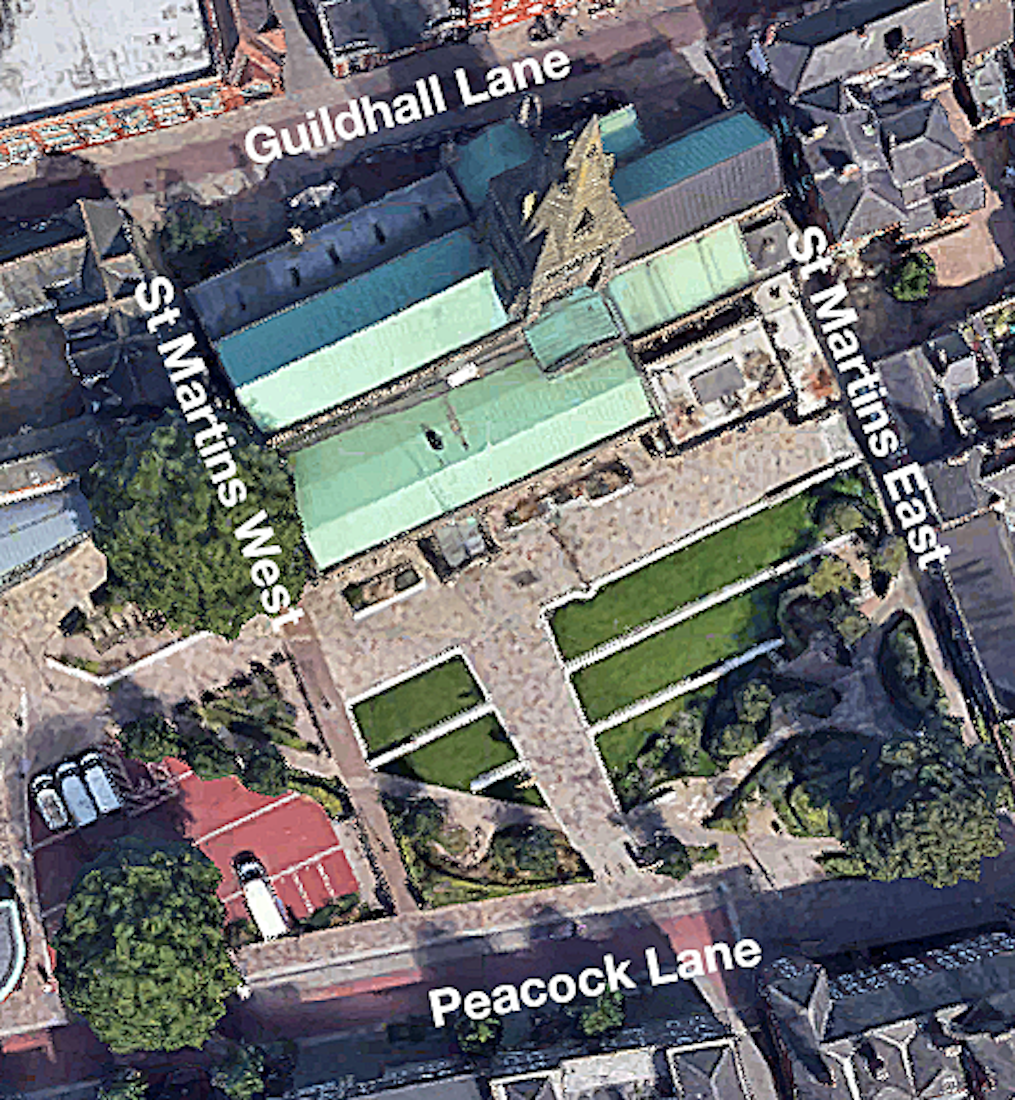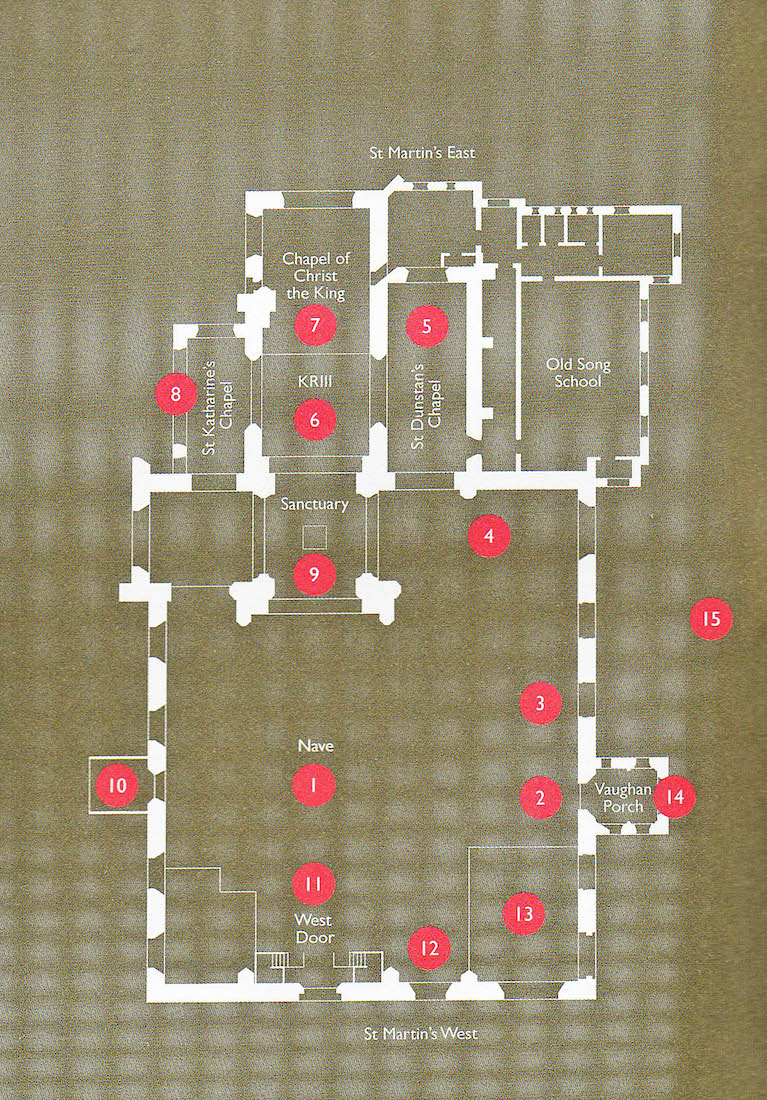WELCOME TO
LEICESTER CATHEDRAL
LEICESTERSHIRE ENGLAND
PAUL SCOTT

SATELLITE VIEW
The main axis of Leicester Cathedral is about 30° skew of geographic east-west, with the sanctuary pointing in a direction north of east. We shall be using liturgical directions with for example East (with a capital E) in a direction pointing 30° in an anticlockwise direction from geographic east (with a small e).
The Cathedral was originally cruciform in shape with a central tower, but side aisles and chapels have been added, and in particular a large space to the South – obliterating the South transept. A rectangular sacristy area has also been added to the Southeast corner.
We shall approach the Cathedral travelling West along Guildhall Lane, work our way around to the South garden area, and then enter the South nave through the Vaughan Porch in line with the wide path up from Peacock Lane.

This plan comes from the Short Cathedral Guide. The numbers will give us an excellent guide. They indicate the following ...
1. Nave [15]
2. South Aisle [No photo]
7. Chapel of Christ the King [42]
10. North Porch [6]
11. West Door [No photo]
In fact, we shall investigate the Cathedral by walkig in a clockwise direction from the Vaughan Porch, but you can access intermediate points in the tour by a tap / click on the links above.
A brief history from Wikipedia follows, but if you want to proceed now with the tour of the Cathedral, click on START .
NOTE ON MAGNIFYING IMAGES
With this website format the images are large enough for most purposes. If there is a need for greater magnification of an image, go to the identical photo on
https://www.flickr.com/photos/paulscottinfo/albums
and use Command - + (Mac) or Windows - + (Windows).
HISTORY
[Wikipedia]
A church dedicated to St Martin has been on the site for about 900 years, being first recorded in 1086 when the older Saxon church was replaced by a Norman one. The present building dates to about that age, with the addition of a spire and various restorations throughout the years. Most of what can be seen today is a Victorian restoration by architect Raphael Brandon. The cathedral of the former Anglo-Saxon diocese of Leicester was on a different site.
A cenotaph memorial stone to Richard III was until recently located in the chancel; it was replaced by the tomb of the king himself. The monarch, killed in 1485 at the Leicestershire battlefield of Bosworth Field, had been roughly interred in the Greyfriars site, Leicester. His remains were exhumed from the Greyfriars site in 2012, and publicly confirmed as his, following DNA testing in February 2013. Peter Soulsby, Mayor of Leicester, and David Monteith, the Cathedral’s canon chancellor, announced the king’s body would be re-interred in Leicester Cathedral in 2015. This was carried out on 26 March.
The East Window was installed as a monument to those who died in World War I. The highest window contains a sun-like orb with cherubs radiating away from it. In the centre Jesus sits holding a starry heaven in one hand with one foot on a bloody hell. Surrounding Jesus are eight angels whose wings are made from a red glass. To the far right stands St Michael the Archangel, who stands on the tail of a dragon. The dragon goes behind Jesus and can be seen re-emerging under the feet of St George who stands on its head. On the bottom row can be seen from left St Joan of Arc, Mary, Jesus with crying angels, Mary Magdalene, James, and St Martin of Tours. The window includes an image of a World War I soldier.
The tower and spire were restored both internally and externally in 2004–5. The main work was to clean and replace any weak stonework with replacement stone quarried from the Tyne Valley. The cost was up to £600,000, with £200,000 being donated by the English Heritage, and the rest raised through public donations.
The Cathedral has close links with Leicester Grammar School which used to be located directly next to it. Morning assemblies would take place each week on different days depending on the school’s year groups, and services were attended by its pupils. The relationship continues despite the school’s move to Great Glen, about seven miles south of Leicester.
In 2011, after extensive refurbishment, the Cathedral’s offices moved to the former site of Leicester Grammar School, and the building was renamed St Martin’s House. The choir song school also relocated to the new building, and the new site also offers conference rooms and other facilities that can be hired out. The new building was officially opened by the Bishop of Leicester in 2011.
In July 2014, the Cathedral completed a redesign of its gardens, including installation of the 1980 statue of Richard III. Following a judicial review decision in favour of Leicester, plans were made to reinter Richard III’s remains in Leicester Cathedral, including a new tomb and a wider reordering of the Cathedral interior. Reinterment took place on 26 March 2015 in the presence of Sophie, Countess of Wessex (representing the Queen) and Prince Richard, Duke of Gloucester.
On 13 April 2017, Queen Elizabeth II distributed Maundy money in the cathedral to 182 recipients.
https://en.wikipedia.org/wiki/Leicester_Cathedral



